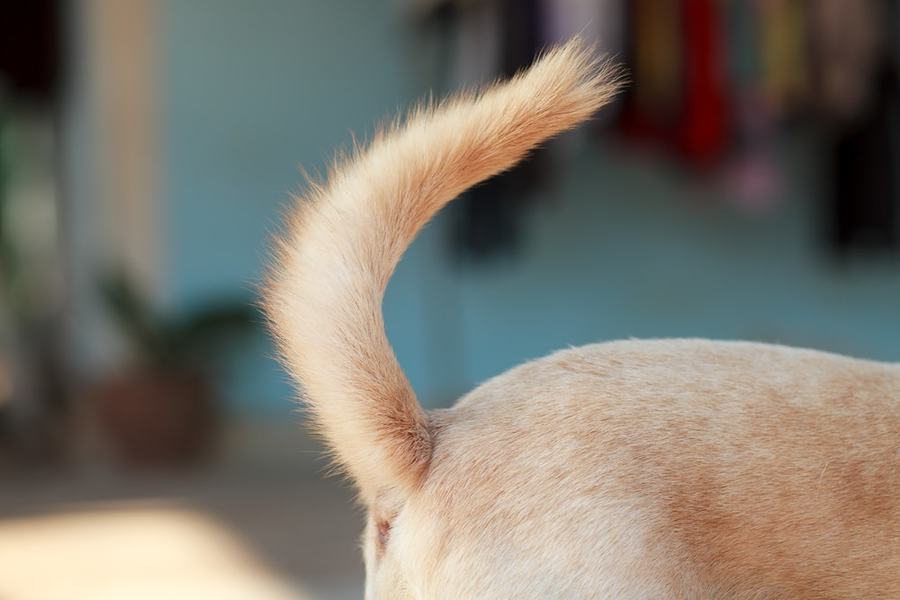“This post contains affiliate links, and I will be compensated if you make a purchase after clicking on my links.”
While it sounds like a pleasant thing, ‘Happy Tail’ can actually be a serious problem for dogs. Happy Tail refers to a generic canine condition characterized by an injury at the tip of a dog’s tail due to vigorous wagging against a particularly hard surface such as an end table or a kennel wall. Normally, the wound is rather superficial, but since it’s located at a delicate part of the body, it bleeds slightly, doesn’t heal very easily, and is even likely to recur.

Common Signs to Watch Out for
The hallmark sign of happy tail is a wound or cut at the tip of a dog’s tail. Due to the weak vascular nature of its location, as well as the exuberant wagging that takes place even right after injury, the wound is likely to start merely as a tiny cut and eventually turn into a chilling splish-splash of blood patterns. However terrifying this can be, the extent of blood Fido has lost is hardly ever dangerous. The frustrating part here is often about getting his battered tail to heal quickly and for it not to recur.
Who Are Usually At Risk
Large short-haired dogs with strong butts and long tails are commonly predisposed to happy tail. Breeds like Pit Bulls, Labrador Retrievers, Great Danes, and Greyhounds are most commonly at risk.
How to Treat Happy Tail
1. Stop the bleeding. To speed up blood coagulation as well as clotting, you need to cool the dog’s wound with an ice pack. Just be careful not to over-cool the tissues as this can result in frostbite.
2. Apply a dressing. Any kind of bandage you wish to apply has to allow your dog’s injured tail to breathe and should NOT cut off circulation. Tails are quite hard to strap up as the extra padding makes the dressing heavy; causing it to slip-up easily. However difficult this can be, never resort to the use of a heavy tape because it won’t stretch and is waterproof. Instead, try covering the tip of Fido’s tail with a syringe case or a prescription vial with drilled holes to allow ventilation. These substitutes are light and can protect the wounded tail tip from any more injury. As a matter of fact, a lot of vets use this as an alternative.
3. Clean the wound. The moment the bleeding has been stopped, and you see some scab formation, try to clean the wound from matted hair or any debris. To keep the cut from getting infected, use prescribed oral or topical antibiotics.
If your dog’s happy tail persists, moderate amputation may be required. Nevertheless, the best solution for this condition is to help your pooch avoid happy tail in the first place. As much as possible, do not confine Fido where his tail can be struck against anything hard. During crate-training, your pooch’s kennel has to be sizable enough to keep him comfortable and at the same time prevent him from unchecked tail wagging. Because a dog’s fur protects his tail from further injury, never shave it.















Julie Valentine
Aug 7, 2019 at 12:18 pm
A couple years ago our dog, Misty, got happy tail and we took her to the vet and he told us it wasn’t going to heal and she’d end up getting her tail docked. We went to a few websites and tried various bandages, but they all ended up falling off or getting chewed off by our dog. That’s why we developed the happy tail saver, it saved our dogs tail from being amputated, saving us hundreds, if not thousands of dollars. The happy tail saver will still allow let your dog wag their tail while they heal. it is guaranteed to stay on any dog.
Visit the link below to check it out.
happytailsaver.com
Patrick Killian
Nov 2, 2016 at 12:11 pm
There is a new product to help with Happy Tail. I don’t know if I can post links here but you can find it by searching for “Tail-Bandit”.